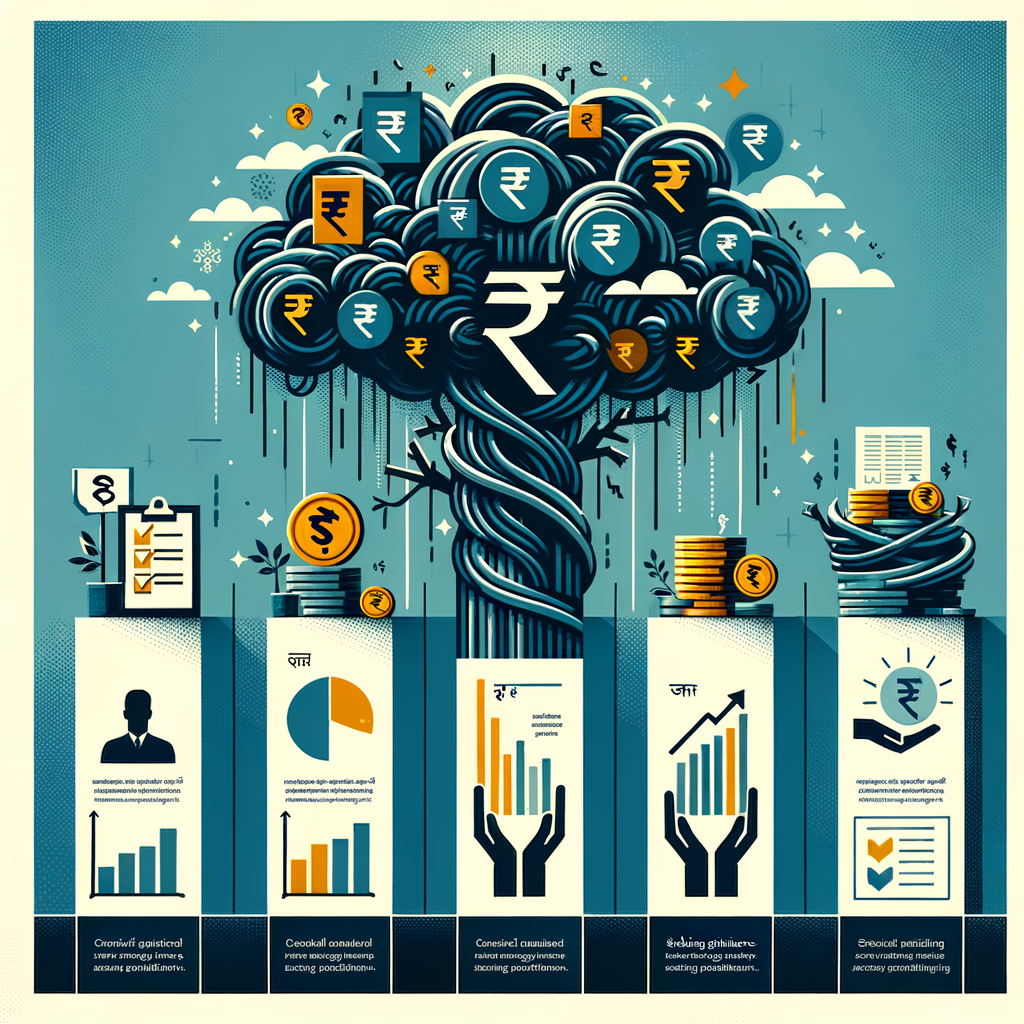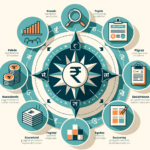Strategies for Overwhelming Debt: What to Do When You’re Swamped
The incessant ringing of the phone with unknown numbers, the sleepless nights spent staring at the ceiling, the sinking feeling in your stomach every time an EMI is due—this is the harsh reality for many dealing with financial strain. If you feel like you’re buried under a mountain of credit card bills, personal loans, and business liabilities, you are not alone. This constant pressure can be paralyzing, but it is crucial to understand that there are clear, actionable strategies for overwhelming debt that can help you regain control. Financial stress is a significant issue for many Indians, but it is a manageable one. This guide is designed to provide you with a step-by-step roadmap, specifically tailored for the Indian context, to help you assess your situation, create a concrete plan, and reclaim your financial future.
Step 1: Face the Numbers – A Clear Assessment of Your Debt
The first and most crucial step in solving a problem is understanding its exact scale. You cannot fight an enemy you cannot see, and ignoring your debt will only make it grow larger. Taking a clear, honest look at your financial situation is not about judgment; it’s about empowerment. It’s the moment you stop running from the problem and start planning your victory over it. This initial assessment will form the foundation of your entire debt-repayment journey, providing the clarity needed to make informed decisions.
Create a Debt Inventory List
To begin, you need to get organized. Grab a notebook or open a simple spreadsheet and create a comprehensive list of every single rupee you owe. This exercise might feel daunting, but it is the most important step toward financial clarity. For each debt, make sure to list the following details:
- Creditor: The name of the bank, NBFC, or individual you owe money to (e.g., HDFC Bank, Bajaj Finserv).
- Type of Debt: Is it a credit card, personal loan, car loan, business loan, or something else?
- Total Outstanding Amount: The total principal and interest due as of today.
- Annual Interest Rate (APR): This is a critical piece of information. The higher the rate, the faster the debt grows.
- Minimum Monthly Payment (EMI): The minimum amount you are required to pay each month.
Your list might look something like this:
| Creditor | Type of Debt | Total Outstanding (₹) | Interest Rate (APR) | Minimum EMI (₹) |
|---|---|---|---|---|
| ICICI Bank | Credit Card 1 | 85,000 | 36% | 4,250 |
| SBI | Personal Loan | 3,50,000 | 14% | 8,200 |
| Local Lender | Hand Loan | 50,000 | 24% | 5,000 |
| Axis Bank | Car Loan | 4,20,000 | 9.5% | 11,500 |
Calculate Your Debt-to-Income (DTI) Ratio
Once you have a clear picture of what you owe, the next step is to understand how your debt compares to your income. This is done by calculating your Debt-to-Income (DTI) ratio. It’s a simple but powerful metric that lenders in India use to gauge your financial health.
The formula is: DTI = (Total Monthly Debt Payments / Gross Monthly Income) x 100
For example, if your total EMIs from the table above are ₹28,950 and your gross monthly salary is ₹70,000, your DTI would be:
(28,950 / 70,000) x 100 = 41.3%
In the Indian financial landscape, a DTI ratio above 40% is often seen as a red flag. It indicates that a significant portion of your income is going towards servicing debt, leaving little room for savings, investments, or emergencies. Knowing this number gives you a clear benchmark of your financial stress level.
Proven Debt Management Strategies in India
With a clear understanding of your financial situation, you can now choose a structured approach to pay it all back. Simply making minimum payments is often a losing battle, especially with high-interest debt. The following are some of the most effective debt management strategies in India that have helped countless individuals and families become debt-free. Choosing the right one depends on your financial situation and your personal psychology. To decide which is better for you, read our detailed comparison on Debt Snowball vs. Debt Avalanche: Which Strategy Is Best for You?.
The Debt Snowball Method: For Psychological Wins
The Debt Snowball method is all about building momentum. It focuses on psychology rather than pure mathematics.
- How it works: You list your debts from the smallest outstanding balance to the largest, irrespective of their interest rates. You continue to make the minimum required payments on all your debts. However, you allocate any extra money you can find in your budget towards paying off the smallest debt first. Once that smallest debt is completely paid off, you take the entire amount you were paying on it (its minimum payment plus the extra) and “roll” it into the payment for the next smallest debt.
- Why it works: Paying off that first, small debt provides a quick, tangible victory. This success creates a powerful psychological boost, motivating you to stick with the plan. Seeing your number of creditors decrease can be incredibly encouraging and helps build the discipline needed for the long haul.
The Debt Avalanche Method: To Save Money on Interest
The Debt Avalanche method is the most financially efficient strategy, designed to save you the maximum amount of money in interest payments over time.
- How it works: With this method, you list your debts from the highest interest rate (APR) to the lowest. You make minimum payments on all debts, but you throw every extra rupee you have at the debt with the highest interest rate. Once that high-interest debt is eliminated, you roll its entire payment amount over to the debt with the next-highest interest rate.
- Why it works: This approach tackles the most “expensive” debt first. High-interest debt, like credit card balances, can grow incredibly fast. By eliminating it first, you stop more interest from accumulating, which means you pay less money to the banks over the life of your loans and become debt-free faster.
Debt Consolidation: Combining Debts into One EMI
Debt consolidation is a financial tool where you take out a single, new loan to pay off multiple existing debts. The goal is often to secure a lower interest rate than what you’re paying on your current high-interest loans (like credit cards or personal loans). To weigh your options carefully, it’s important to understand The Pros and Cons of Debt Consolidation: What You Need to Know.
- Pros in India:
- Simplicity: You only have to manage one EMI payment to one lender, which simplifies your monthly finances.
- Lower Interest: If you have a good CIBIL score, you may qualify for a personal loan at a much lower interest rate than your credit cards, saving you significant money.
- Fixed Tenure: You get a clear end date for your debt, which can be highly motivating.
- Cons in India:
- Requires Good Credit: To get a consolidation loan at a favorable rate, you typically need a CIBIL score of 750 or higher.
- Doesn’t Solve the Root Problem: Consolidation is a tool, not a cure. If your spending habits don’t change, you risk running up your old credit cards again, putting you in an even worse position.
- Potential for Longer Tenure: Sometimes, to make the EMI affordable, the loan tenure is extended, which might mean you pay more in total interest over time, even if the rate is lower.
How to Tackle Overwhelming Debt: Custom Plans for Your Situation
The best approach to debt management is not one-size-fits-all. The financial realities of a salaried individual are different from those of a small business owner. Here’s how to tackle overwhelming debt in India with strategies tailored to your specific situation.
Debt Relief Strategies for Salaried Individuals in India
For those with a steady paycheck, the key is to optimize cash flow and leverage the stability of your employment. Here are some debt relief strategies for salaried individuals in India:
- Master Your Budget: A budget is your most powerful weapon. The 50/30/20 rule is an excellent starting point: allocate 50% of your take-home pay to Needs (rent, groceries, utilities, EMIs), 30% to Wants (entertainment, dining out), and 20% to Savings & Debt Repayment. When in heavy debt, you must aggressively shrink the “Wants” category and redirect that money to the “Debt Repayment” portion.
- Negotiate with Your Lenders: Banks and credit card companies are often more willing to negotiate than you think, especially if you have a good payment history. Call your creditor, explain your situation professionally, and ask if you are eligible for:
- A lower interest rate on your credit card.
- A temporary moratorium or pause on payments (if facing a job loss or medical emergency).
- A structured repayment plan that converts your outstanding balance into a manageable EMI.
- Consider Your EPF (Use with Caution): You can take a loan against or make a partial withdrawal from your Employee Provident Fund (EPF) to repay debt. However, this should be a last resort. While it can provide immediate relief, you are borrowing from your own retirement savings, which can have long-term consequences. Before proceeding, carefully review the rules on the official EPFO portal.
Strategies for Small Business Owners
Small business owners face unique challenges, as personal and business finances are often intertwined. The focus here is on improving business cash flow to service debt effectively.
- Aggressive Cash Flow Management: Your business’s cash flow is its lifeblood. Focus on:
- Tightening Billing Cycles: Invoice clients immediately upon completion of work.
- Following Up on Receivables: Be persistent in collecting payments that are due. Offer small discounts for early payment.
- Reviewing Expenses: Cut any non-essential business expenses until the debt is under control.
- Business Loan Restructuring: If you are struggling with a business loan EMI, don’t wait to default. Proactively approach your lender and discuss the possibility of loan restructuring. This could involve extending the loan tenure to reduce the monthly EMI, providing you with breathing room.
- Explore Government Schemes: The Indian government offers several schemes to support Micro, Small, and Medium Enterprises (MSMEs). Schemes offered through SIDBI or other public sector banks might provide loans at more favorable terms, which you could use to refinance existing, high-cost business debt. Registering your business on the Udyam Registration Portal is the first step to accessing many of these benefits.
- Expert Financial Guidance: Managing business debt can be complex. Services like MSME Registration and Business Financial Consulting from TaxRobo can provide expert guidance on structuring your finances and navigating the path to profitability.
The Human Side: Ways to Deal with Stress from Debt in India
The financial numbers are only half the story. The mental and emotional burden of debt can be crushing, leading to anxiety, depression, and strained relationships. It is vital to find healthy ways to deal with stress from debt in India while you work on the financial side.
Shift Your Focus to the Plan, Not the Problem
Constant worry about the total amount you owe is paralyzing. Once you have created a repayment plan (like the Snowball or Avalanche method), shift your mental energy. Instead of focusing on the mountain of debt, concentrate on the next small step: making this month’s extra payment, cutting a specific expense, or clearing that one small loan. This creates a sense of control and forward momentum, which is a powerful antidote to anxiety.
Build a Support System
Debt often comes with feelings of shame and isolation, but you do not have to go through this alone. Talking about your situation with a trusted and non-judgmental friend, family member, or spouse can be incredibly relieving. If you don’t feel comfortable sharing with someone you know, consider speaking to a financial advisor or a counselor. The act of sharing the burden can make it feel much lighter.
Track Your Progress and Celebrate Small Victories
Your journey out of debt is a marathon, not a sprint. To stay motivated, it’s essential to acknowledge your progress. Keep your debt inventory list updated and watch the balances go down. When you pay off a single credit card or a small loan, celebrate it! This doesn’t mean a lavish expense; it could be a special home-cooked meal or a day out at a park with your family. These small rewards reinforce positive financial behavior and remind you that your hard work is paying off.
Conclusion: Your Path to a Debt-Free Future
Overcoming a significant debt burden is a challenging journey, but it is absolutely achievable. The path to financial freedom begins with a few clear steps: honestly assessing your debt, choosing a systematic repayment strategy like the Debt Snowball or Avalanche, implementing solutions tailored to your life as a salaried individual or business owner, and actively managing the mental stress that comes with it. By implementing these strategies for overwhelming debt, you are not just paying off bills; you are taking a powerful and decisive step towards building a secure and prosperous future.
Feeling overwhelmed is normal, but staying stuck isn’t an option. If you need expert guidance to navigate your financial challenges and explore effective debt solutions for Indians, the team at TaxRobo is here to help. Contact us for a confidential consultation and let’s build your debt-free plan together.
Frequently Asked Questions (FAQ)
Q1. Will using debt management strategies hurt my CIBIL score in India?
Answer: No, quite the opposite. Systematically paying down your debt using methods like the Snowball or Avalanche will improve your CIBIL score over time as your credit utilization ratio decreases and your payment history strengthens. While debt consolidation may cause a temporary, small dip in your score due to the hard inquiry for the new loan, making consistent payments on that new loan will boost your score significantly in the long run.
Q2. What is the first thing I should do if I miss an EMI payment?
Answer: Contact your lender immediately. Do not ignore their calls or letters. Banks are far more willing to work with a borrower who is proactive and honest about their situation. Proactively explaining your difficulty and asking for a solution (like a short grace period or a temporary interest-only payment) is much better than defaulting without any communication, which negatively impacts your CIBIL score and relationship with the lender.
Q3. Are debt settlement companies in India a good idea?
Answer: You should be extremely cautious. While some legitimate financial advisors can help, many “debt settlement” companies charge high upfront fees and their primary tactic is to have you stop paying your lenders, which severely damages your CIBIL score for up to seven years. The “settled” remarks on your credit report are a major red flag for future lenders. It is almost always better to try negotiating directly with the bank yourself or to seek advice from a trusted, fee-only financial advisor first.
Q4. How can I build an emergency fund while paying off debt?
Answer: This is a crucial step to break the debt cycle. Start small, even if it feels insignificant. Aim to save just ₹1000-₹2000 per month in a separate savings account that you do not touch. The goal is to build a small cushion (aim for at least one month’s essential expenses). This small emergency fund will prevent you from having to take on new credit card debt or a personal loan when an unexpected expense like a car repair or medical bill arises. For more detailed strategies, read our guide on Building an Emergency Fund While Managing Debt.



